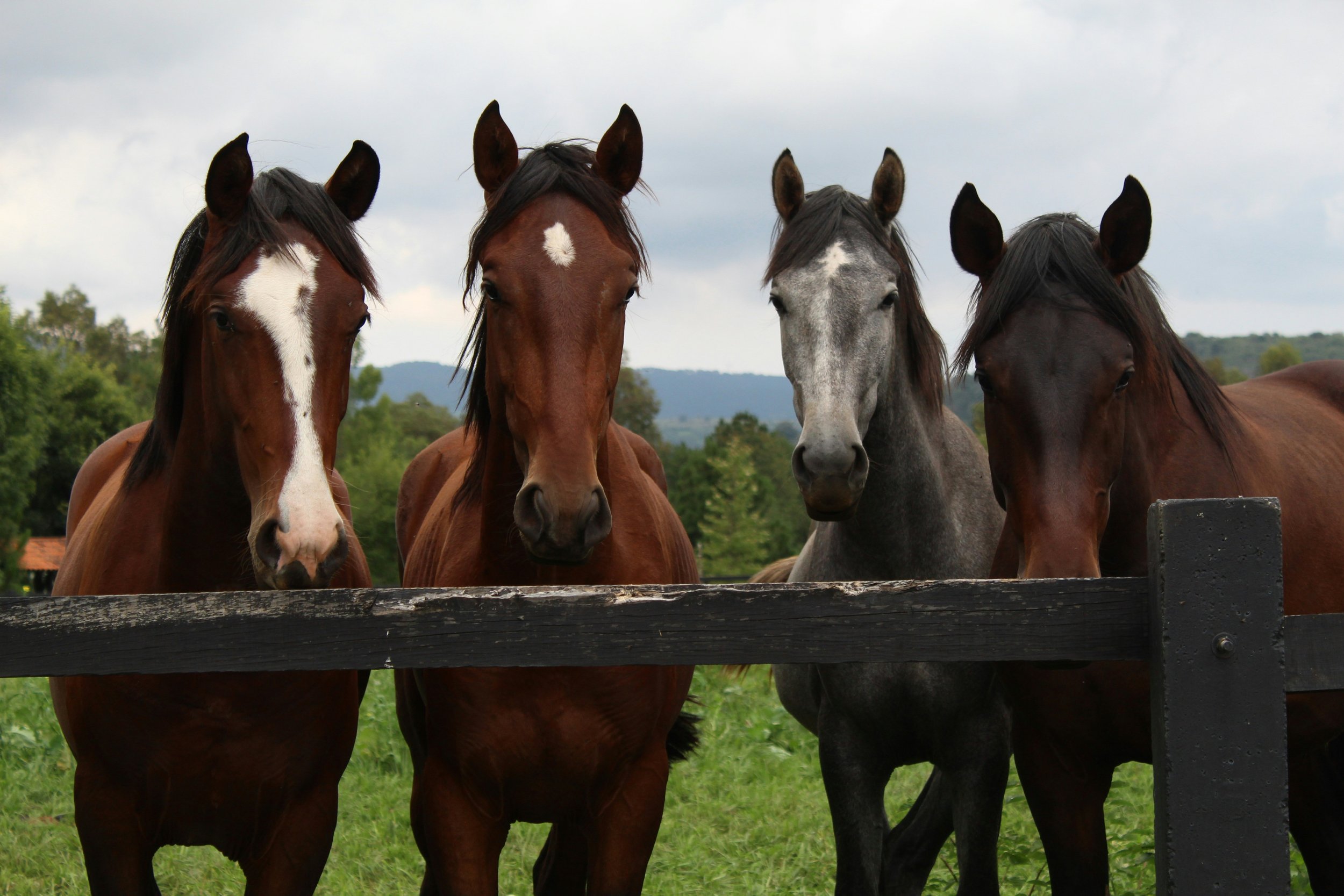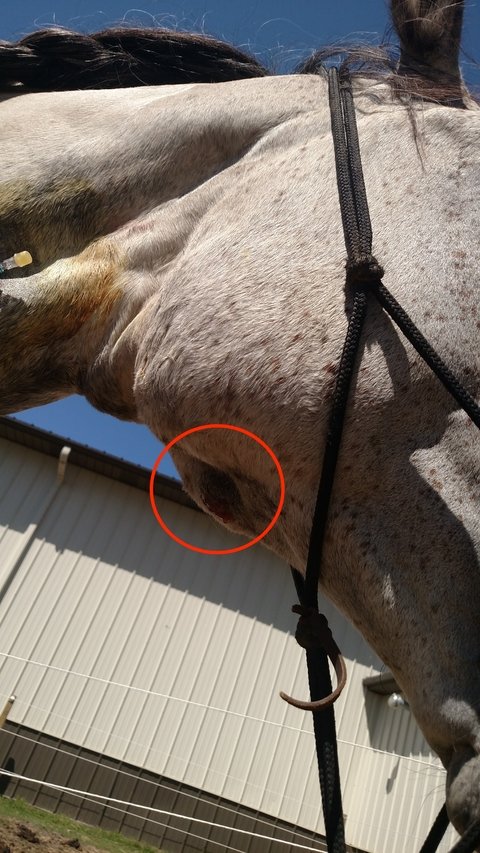
Strangles
Clinical Signs, Treatment, and Prevention
Strangles is an upper respiratory disease of horses caused by the bacteria Streptococcus equi subspecies equi (S. equi). The disease has been reported as early as the thirteenth century. It causes a distinctive swelling under the jaw and around the neck, prompting early veterinarians to name the disease "strangles". Despite the colorful name I have never seen a horse "strangle" to death but I have seen horses that looked close to death.
Clinical Signs:
In typical cases, horses develop a high fever, are depressed, and develop a clear nasal discharge that becomes thick and white. The mandibular and retropharyngeal lymph nodes are initially firm but become fluctuant and swollen attributing to the colorful name of the disease. The swelling under the throat latch may become so severe that the horse has difficulty swallowing or difficulty breathing. The lymph nodes rupture at 7 to 10 days after the onset of signs. Ruptured lymph nodes drain a white to yellow pus for several days. A soft moist cough may be heard in some horses.
The average course of the syndrome is 23 days from exposure to resolution. The incubation period ranges from 2 to 6 days after exposure to the bacteria.
Sequelae:
Some horses that develop the disease will resolve and the horse will be completely normal, some of the horses will develop serious complications, and some will become asymptomatic carriers. Complications most frequently result from metastasis of the organism to other organ systems with the formation of abscesses.
Possible resulting complications include:
• Internal abscessation of the abdomen or of other organs (often called Bastard Strangles). The causes of internal abscessation are not known, although inadequate antibiotic therapy or antibiotic therapy at the wrong time may be contributory. The horse may have a history of intermittent colic, periodic fever, anorexia, depression, and weight loss.
• Purpura hemorrhagica. This is the most devastating and the most dangerous potential complication. Purpura hemorrhagica causes severe inflammation to the blood vessels called vasculitis. It can occur following exposure to S.equi by natural infection or following vaccination. The clinical signs of purpura hemorrhagica vary and range from a mild transient reaction to severe vasculitis and even death.
Horses with purpura develop swelling of the limbs, head, and trunk. The vasculitis may cause skin sloughing. Hemorrhage of the mucus membranes can be seen. Horses may also develop colic due to swelling and hemorrhage of the bowel. Death may ensue as a result of pneumonia, cardiac arrhythmias, renal failure, or gastrointestinal disorders.
• Guttural pouch empyema and chondroid formation. There is a large sac in the throat latch called the guttural pouch. This sac can become filled with pus. Sometimes the pus will develop into hard masses called chondroids.
These horses can become asymptomatic carriers. Outwardly the horse will seem normal but it can transmit strangles to other horses on the farm. These asymptomatic carriers can be very hard to identify. One asymptomatic carrier can cause outbreaks of strangles on the farm for years and can make efforts to control the spread of disease frustrating or futile.
Epidemiology:
The infection occurs primarily in horses 1 to 5 years old but is not restricted to this age group. In susceptible equine populations, morbidity is nearly100%. That is a sophisticated way to say if one horse in the barn get strangles usually several or all of the horses in the barn get strangles. The good news is that the mortality is low (up to 10%) if appropriate therapy is instituted.
It was once believed that if a horse has recovered from strangles that that horse was immune for the rest of its life. This is not exactly true, immunity is not lifelong. Once having been infected, approximately 75% of the horses are immune to the organism for 4years. Some of those horses will develop into asymptomatic carriers.
The organism is transmitted:
1. Via direct contact with nasal secretions or lymph node discharges from infected horses
2. Via exposure to fomites such as contaminated equipment, pails, halters, leads, brushes, clothing, horse vans, or stalls.
3. Via exposure to asymptomatic carriers
Be aware that horses that have symptoms of strangles can transmit the disease to other horses several months after resolution of symptoms. Asymptomatic carriers can transmit strangles to other horses for up to four years.
The organism can survive for long periods in the environment; S. equi survived for 63 days on wood at temperatures of 36 degrees Fahrenheit and for 48 days on glass or wood at temperatures of 68 degrees Fahrenheit.
Fortunately S. equi is easily killed with disinfectants such as bleach, povidone-iodine, chlorhexidine, and glutaraldehyde. Any one of these disinfectants will kill the organism in the environment within 90 minutes.
Treatment:
Treatment is very dependent on the stage of the disease.
For horses exposed to the organism but not yet showing swelling of the lymph nodes, antibiotic therapy can be used to prevent seeding of the pharyngeal lymph nodes. Antimicrobial therapy should continue for as long as the horse remains exposed to the organism. Remember that can be up to 30 days in the environment or longer if the horse remains in contact with a carrier.
For horses exhibiting evidence of lymph node swelling or abscessation, the administration of antibiotics slows the progression of lymph node abscessation. Using antibiotics in these horses can lead to bastard strangles or purpura hemorrhagica. Antibiotics should not be used in horses while they exhibit lymph node swelling.
Horses should be treated symptomatically until an abscess forms. Hot-packing the swollen areas promote abscess formation. Once an abscess has formed, the veterinarian can lance the abscess and flush it with wound irrigation solution. At that time aggressive antibiotic therapy can begin.
Horses that are severely systemically ill or that develop complications such as difficulty swallowing or respiratory distress require supportive care in addition to high levels of intravenous antibiotics. This therapy may entail intravenous fluid therapy, a tracheotomy, nonsteroidal anti-inflammatory drugs, and feeding via a nasogastric tube.
Remember that strangles is very contagious thus all horses in treatment should be isolated from other horses.
Prevention:
An owner should attempt to reduce transmission of S. equi during an outbreak.
Prevent spread of infection to horses on other premises and to new arrivals by immediately stopping all movement of horses on and off the premises.
Owners can identify symptomatic and asymptomatic carriers by sampling nasopharygneal or guttural pouch regions weekly.
Isolate infectious horses from those screened negative for S. equi. Cordon off an isolation area and have infectious horses looked after by a dedicated staff wearing protective clothing and footgear.
Disinfect stalls, aisles, and equipment.
Vaccination:
At Conley and Koontz Equine Hospital we recommend that all mares be vaccinated with intranasal vaccine 30 days before giving birth. Foals should be vaccinated with intranasal vaccines at five and six months of age. Adult horses with any risk of exposure to strangles should be vaccinated yearly with the intranasal vaccine.
None of the vaccines currently on the market guarantee prevention of strangles in vaccinated horses. However the intranasal vaccine used by Conley and Koontz Equine Hospital veterinarians give the best protection with the fewest side effects. If vaccinated horses do develop the disease from natural exposure the symptoms are usually lessened, the duration is shorter, and the carrier state is shorter.
In isolated cases horses can develop strangles-like symptoms from the vaccination. While the horse may experience fever, poor appetite, and even swollen lymph nodes this syndrome is not actual strangles. The symptoms are usually transitory and short lived. The affected horse cannot spread the disease to other horses.
Effective immunity after vaccination takes 7 to 10 days to develop. Peak immunity does not occur for 21 to 28 days. If you have an unvaccinated horse that is moving to a high risk environment; such as a show, trail riding or a breeding farm, it is best to vaccinate at least 30 days before exposure.
